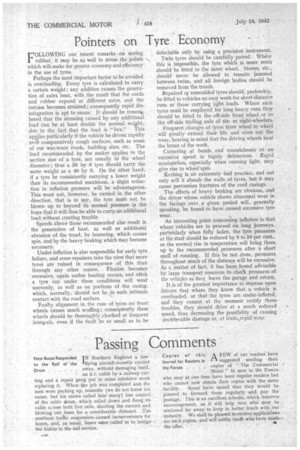Pointers on Tyre Economy
Page 18

If you've noticed an error in this article please click here to report it so we can fix it.
COLLOWING our recent remarks —on saving rubber, it may be as well to stress the points which will make for greater economy and efficiency in the use of tyres. \ Perhaps the most important factor to be avoided is overloading. Every tyre is calculated to carry a certain weight ; any addition causes the generation of extra heat, with the result that the cords and rubber expand at different rates, and the carcass becomes strained ; consequently rapid disintegration is apt to ensue. It should be remenebered that the stressing caused by any additiOnal load can be at least double the normal weight, due to the fact that the load is "live." This applies particularly if the vehicle be driven rapidly over comparatively rough surfaces, such as some of our war-worn roads, building, sites, etc. The load recommended by the maker applies to the section size of a tyre, not usually to the wheel diameter ; thus a 38 by ,8 tyre should tarry the same weight as a 40 by 8. On the other hand, if a tyre be consistently carrying a lower weight than its recommended maximum, a slight reduction in inflation pressure will be advantageous. This must not, however, be carried in the other direction, that is to say, the tyre must not be blown up to beyond its normal pressure in the hope that it will thus be able to carry an additional load without creating trouble.
Speeds above those recommended also result in the generation of heat, as well as additional abrasion of the tread, by bouncing, which causes spin, and by the heavy braking which may become necessary.
Under-inflation is also responsible for early tyre failure, and some repairers take the view that more tyres are ruined in consequence of this than through any other reason. Flexion becornes .excessive, again undue heating occurs, and often a tyre run under these conditions will weal. unevenly, as well as on portions of the casing, which, normally, should not be in such intimate contact with the road surface.
Faulty alignment, in, the case of tyres on front wheels causes much scuffing ; consequently these wheels should be thoroughly checked at frequent interyals, even if the fault be so small as to -be detectable only by using a precision instrument. Twin tyres should be carefully paired. Where this is impossible,. the tyre which is more worn should be fitted to the inner wheel. Stones, etc., should never be allowed to remain jammed between twins, and all foreign bodies should be removed from the treads.
Repaired or remoulded tyres should, preferably, be fitted to vehicles on easy work for short-distance runs or those carrying light loads. Where such tyres must be employed for long heavy runs they should be fitted to the off-side front wheel, or to the off-side trailing axle of sixor eight-wheelers.
Frequent changes of tyres from wheel to wheel will greatly extend their life and even out the wear, bearing in mind that the driving wheels bear the brunt of the work.
• Cornering at bends and roundabouts at an excessive speed is highly deleterious. Rapid acceleration, especially when running light, may give rise to wheel'spin.
Kerbing is an extremely bad practice. and not only will it abrade the walls of tyres, but it may cause percussion fractures of the cord casings.
The effects of heavy braking are obvious, and the driver whose vehicle shows abnormal wear in the facings over a given period will, generally speaking, be found to have caused excessive tyre wear.
An interesting point concerning inflation is that where vehicles are to proceed On long journeys, partienlarly when fully laden, the tyre pressures at the start should be reduced by 8 to 10 per cent., as the normal rise in temperature will bring them up to the recommended pressures after a short spell of running. If this be 'not done, pressures throughout much of the distance will be excessive. As a matter of fact, it has been found advisable by large transport concerns to check pressures of the vehicles as they leave the garage and return.
It is of the greatest importance to impress upon drivers that where they know that avehicle is overloaded, or that the tyres are ,under-inflated, and they cannot at the moment rectify these troubles, they should drive at a much reduced speed, thus decreasing the possibility of causing irretrievable damage or, at leastvapid wear.




















































